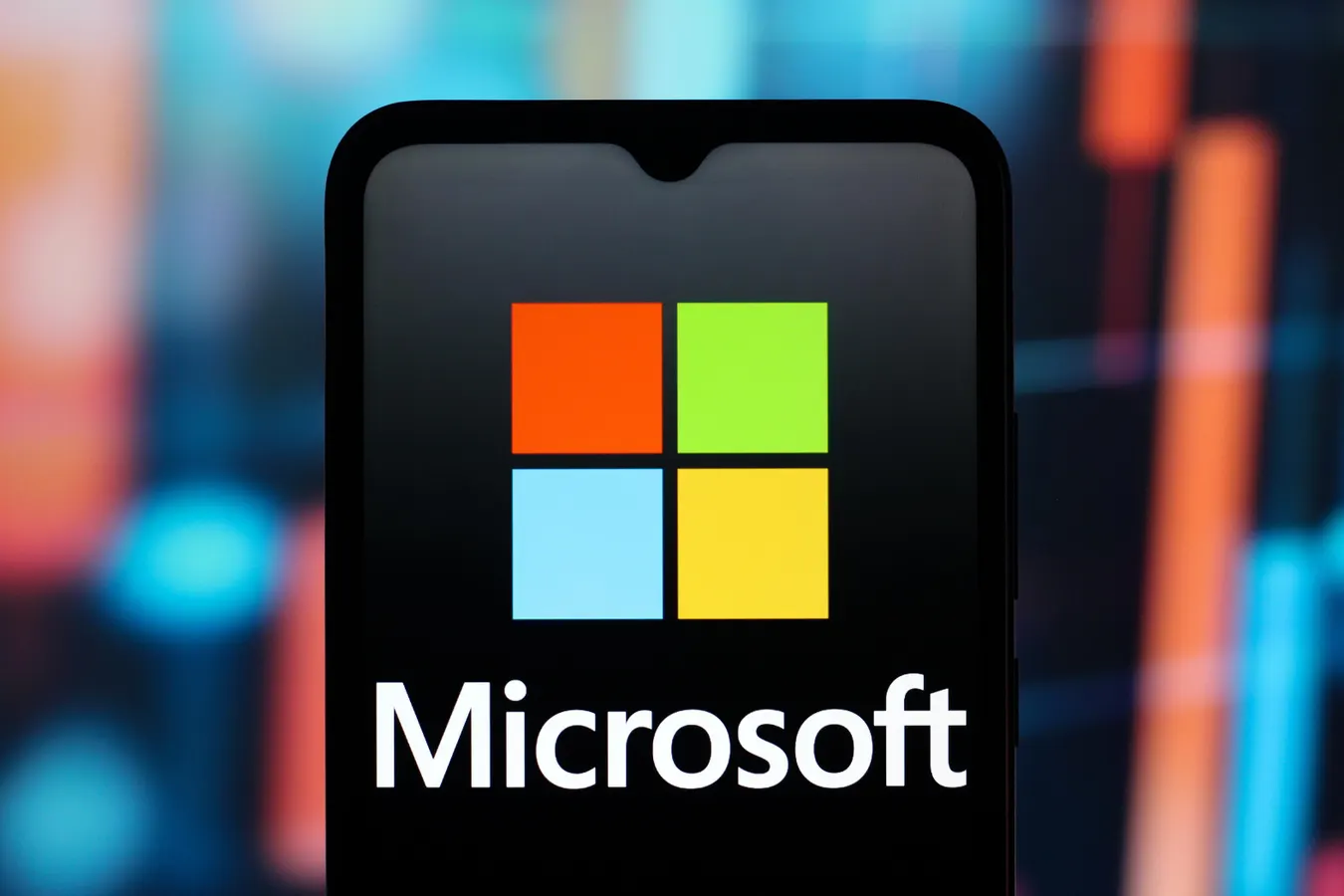By Contributor,Thomas Fuller,Trefis Team
Copyright forbes

CANADA – 2025/09/15: In this photo illustration, the Microsoft Corporation logo is seen displayed on a smartphone screen. (Photo Illustration by Thomas Fuller/SOPA Images/LightRocket via Getty Images)
SOPA Images/LightRocket via Getty Images
We are fond of companies that generate cash. A lot of cash. What about 2% of market capitalization? Microsoft’s stock is valued at $3.9 trillion and generated $71.6 billion in free cash flow in fiscal 2025, which is about 1.8% of its market capitalization. On a per-share basis, that’s $9.60 of free cash flow for a $520 stock. What’s not to adore? This cash accumulates on the balance sheet, can be reinvested, and fuels buybacks. Microsoft’s operating cash flow margin is at 48.3%, resulting in $136 billion from $282 billion in revenue. Net income? An astonishing $102 billion – a net margin of approximately 36%, marking the inaugural occasion that Microsoft surpassed the $100 billion profit threshold. The balance sheet resembles a fortress, boasting $95 billion in cash compared to $61 billion in debt, indicating a robust net cash position. Simultaneously, Microsoft returned $37 billion to shareholders through dividends and buybacks within the last twelve months alone. See – Why Microsoft Stock Is A Shareholder’s Paradise? – for additional insights.
Although Microsoft stock has experienced a strong year, appreciating by 24% and surpassing the NASDAQ’s 18% gain, the crucial question now is: Is there still room for Microsoft stock to grow?
An in-depth examination of the company’s fundamentals indicates that the answer is yes, as growth is swiftly accelerating.
Microsoft reported impressive results for fiscal year 2025, with revenue and operating income rising in the mid to high teens. A key contributor to this performance is the Intelligent Cloud segment. Azure alone surpassed $75 billion in annual revenue, exhibiting remarkable growth of 34% year-over-year. Artificial Intelligence (AI) services are a major tailwind, accounting for 19 percentage points of that growth.
The company is sustained by several massive, long-term growth drivers—most notably, the expansion of its AI offerings. These factors are anticipated to drive the stock to significantly higher levels, potentially doubling from its current price to exceed $1,000. We will delve into these specific growth drivers in greater detail. That being said, if you’re looking for upside with less volatility than holding an individual stock like Microsoft, consider the High Quality Portfolio. This portfolio has consistently outperformed its benchmark—a combination of the S&P 500, Russell, and S&P MidCap indexes—and has achieved returns exceeding 91% since its inception. Why is this the case? The HQ Portfolio stocks as a group have provided better returns with less risk compared to the benchmark index; showcasing less volatility, as evident in HQ Portfolio performance metrics. Separately, see – What’s Next For CoreWeave Stock?
Several Big Growth Drivers
AI and Cloud Dominance: Microsoft is investing an estimated $70 billion in AI infrastructure during fiscal 2026, constructing the world’s most powerful AI datacenters across over 400 locations globally. Azure revenue reached $75 billion in fiscal 2025 with 34% growth, fueled by both traditional cloud migrations and a dramatic increase in AI workload adoption. Microsoft Cloud revenue amounted to $186 billion annually, up 27%, with the involvement of AI services on the rise. The company’s integrated AI stack – from infrastructure to applications like Copilot – is already enhancing revenue growth, with broader enterprise adoption anticipated in the years ahead.
Enterprise Software and Productivity: The Productivity and Business Processes segment generated $116.5 billion in fiscal 2025, a 16% increase. Office 365 commercial revenue rose by 16%, while LinkedIn revenue increased by 8%. Dynamics 365 soared 19% as customers transitioned to cloud-based business applications. Microsoft is capitalizing on higher pricing for its products by incorporating AI-enhanced features that seamlessly improve existing user workflows. This will aid in accelerating revenue.
Gaming and Consumer Technology: Despite Xbox hardware sales declining by 22%, Xbox content and services revenue rose by 13%, showcasing the transition toward higher-margin subscription and cloud gaming models. The More Personal Computing segment contributed $54 billion in fiscal 2025, with steady growth in Windows licenses and search advertising driven by AI integration within consumer products.
MORE FOR YOU
How Microsoft Stock Reaches $1,000
Let’s analyze the figures. Microsoft generated $281.7 billion in revenue in fiscal 2025, showing an accelerating growth trend. With AI adoption driving sustained annual revenue growth of 17% and margin expansion through operational leverage, sales could reach $450 billion by 2028. Microsoft’s operating margins are expected to expand to 50% as high-margin AI services scale up and operational efficiency improves. This equates to roughly $225 billion in operating income, or about $180 billion in net income after taxes.
With ongoing share repurchases decreasing the float, the share count could trend toward 7.2 billion shares. This would imply an EPS of around $25 per share by 2028. Now, let’s discuss valuation. While Microsoft currently trades at 38 times trailing earnings (based on fiscal 2025 results), its AI monetization narrative justifies a premium valuation. Given Microsoft’s robust growth, superior margins, and strong cash flow generation, we do not expect any significant compression in multiples over the next three years.
Implied Share Price:
Even a conservative multiple of 30 times—reflecting a mature AI growth narrative while adhering to reasonable valuation discipline—indicates a share price of $750.
If the company maintains its current multiple of about 40 times, the implied share price could exceed $1,000, signifying a doubling from present levels.
What Are The Risks?
Despite Microsoft’s promising outlook, potential risks could impede the stock from doubling. The most significant concern is the normalization of AI spending, where businesses may become more cautious about initiating new Azure projects, implying that the current investment pace may not be sustainable indefinitely. Additionally, heightened competition from Google, Amazon, and emerging entities could exert pressure on Microsoft’s AI pricing power and market share growth.
See, investing in a single stock without a thorough analysis can be perilous. Consider the Trefis Reinforced Value (RV) Portfolio, which has outperformed its all-cap stocks benchmark (comprising the S&P 500, S&P mid-cap, and Russell 2000 benchmark indices) to generate strong returns for investors. Why is that? The quarterly rebalanced combination of large-, mid-, and small-cap RV Portfolio stocks offered a responsive method to maximize gains during favorable market conditions while mitigating losses when markets decline, as detailed in RV Portfolio performance metrics.
The Bottom Line
Microsoft’s investment appeal is compelling. Record cash generation of $72 billion and an indomitable balance sheet finance both aggressive AI infrastructure investments and steady shareholder returns, while diverse exposure across cloud, AI, enterprise software, and gaming diminishes risk and positions the company for continued long-term growth. The anticipated $70 billion AI infrastructure investment fosters competitive advantages that enhance market share growth, with additional upside potential arising from AI-driven margin expansion while sustaining accelerating growth. That said, investors should judiciously consider the risks prior to investing in Microsoft.
Editorial StandardsReprints & Permissions



